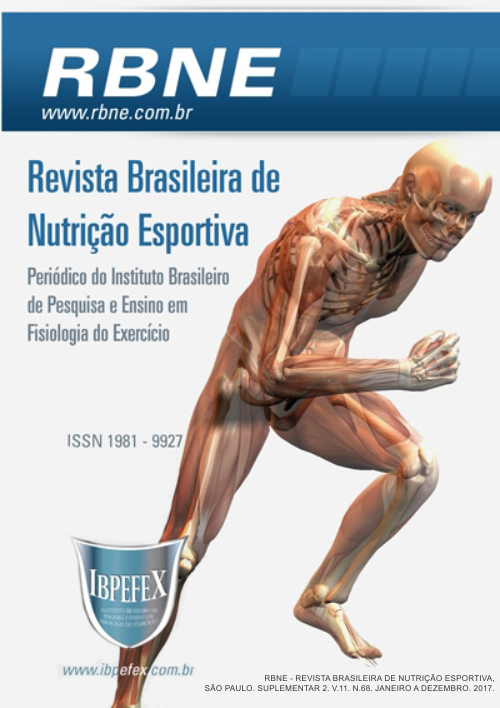Anthropometric profile, food frequency and utilization of ergogenic resources in rugby youth players from Caxias do Sul-RS
Abstract
Introduction: Rugby is a popular sport consisting of a team with 15 regular players, who use their hands to carry and throw an oval ball. It is a sport that demands great physical effort, generating nutritional exhaustion, which can disrupt other normal activities of the studied age group. Aim: To evaluate the anthropometric profile, the feeding frequency and the use of ergogenic resources by the athletes of a juvenile team of Rugby. Methods: A descriptive cross-sectional study was carried out with a team of Rugby players from the city of Caxias do Sul. The anthropometric profile (weight, height, body mass index, waist circumference and folds cutaneous), food frequency and the use of ergogenic resources. Results: It was verified that the players were classified with overweight and a significant variation in the percentage of body fat. In addition, it was observed that the players do not have adequate diet and supplementation for sports practice. Conclusion: The anthropometric evaluation showed great variation among the players. It was observed that athletes do not have adequate diet or nutritional guidance regarding the use of dietary supplements, which may compromise performance and recovery during official training and games.
References
-Alves C.; Lima B.V.R.; Uso de suplementos alimentares por adolescentes. Jornal de pediatria. Vol. 85. Num. 4. 2009. p. 287-294.
-Brasil. Ministério da Saúde. Secretaria de Vigilância em Saúde. Vigitel Brasil 2013: vigilância de fatores de risco e proteção para doenças crônicas por inquérito telefônico / Ministério da Saúde, Secretaria de Vigilância em Saúde. Brasília: Ministério da Saúde. 2014a.
-Brasil. Ministério da Saúde. Secretaria de atenção à saúde. Departamento de atenção Básica. Guia alimentar para a população brasileira / ministério da saúde, secretaria de atenção à saúde, departamento de atenção Básica. 2. ed. Brasília: Ministério da Saúde. 2014b.
-Brasil. Ministério da Saúde. Portaria no 32, de 13 de janeiro de 1998. A Agência Nacional de Vigilância Sanitária aprova o regulamento técnico para fixação de identidade e qualidade de suplementos vitamínicos e ou de minerais. Diário Oficial da União 15 jan.1998. 1998.
-Dalgê J.J. Hábitos alimentares de adolescentes de uma escola de Cordeirópolis, SP. Monografia de pós-graduação. UTFP-PR. Paraná. 2014.
-Domingues, S.F.; Marins, J.C.B. Utilização de recursos ergogênicos e suplementos alimentares por praticantes de musculação em Belo Horizonte-MG. Rev. Fitness Performance. Vol. 6. Num. 4. 2007. p. 218-226.
-Fonseca, M. D. J. M. D.; Chor, D.; Valente, J. G. Hábitos alimentares entre funcionários de banco estatal: padrão de consumo alimentar. Cadernos de Saúde Pública. Vol. 15. Num. 1. p. 29-40.1999.
-Lopes, A.L.; Pinheiro, E.S.; Cunha, G.S.; Sapata, K.; Martins, J.B.; Carteli, R.B.; Ribeiro, G.S.; Cardoso, M.S. Análise da composição corporal e da capacidade aeróbica em jogadores de rugby. EFDeportes. Vol. 16. Num. 158. 2011.
-Mendes, E.L.; Junior, R.A., Andaki, A.C.R., Junior, M.M., Simim, M.A.M., Mota, G.R.; -Ergogênicos nutricionais e desempenho no Rugby: revisão sistemática. 2013.
-Portal do Rugby. 2016. Disponível em:<http://www.portaldorugby.com.br/entenda-o-rugby/guia-para-iniciantes
-Resolução de diretoria colegiada. RDCnº 18, de 27 de abril de 2010.(Publicada em DOU nº 79, de 28 de abril de 2010). 2010.
-Sant’Anna, M.S.L.; Priore, S.E.; Franceschini, S.C.C. Métodos de avaliação da composição corporal em crianças. Rev. paul. Pediatr. Vol. 27. Num 3. 2009.
-Santos F.G.; RossiL.; Avaliação Antropométrica De Atletas De Rugby. Revista Brasileira de Nutrição Esportiva. Vol. 5. Num. 27. 2011. p. 224-229. Disponível em: <http://www.rbne.com.br/index.php/rbne/article/view/256/251>
-Schneider C.; Machado C.; Laska M.S.; Liberali R. Consumo de suplementos nutricionais por praticantes de exercício físico em academias de musculação de Balneário Camboriú-SC. Revista Brasileira de Nutrição Esportiva. Vol. 2. Num. 11. p. 307-322. 2008. Disponível em: <http://www.rbne.com.br/index.php/rbne/article/view/74>. Acessoem: 20 abr. 2016
-Sociedade Brasileira de Medicina do Esporte. Modificações dietéticas, reposição hídrica, suplementos alimentares e drogas: comparação de ação ergogênica e potenciais riscos para a saúde. Revista Brasileira de Medicina Esportiva. Vol. 15. Num. 3. 2009. p. 3-12.
-Thorland W.G.; Johnson G.O.; Tharp G.D.; Housh T.J.; Cisar C.J. Estimation of body density in adolescent athletes. Human Biology. Vol. 56. Num. 3. 1984. p. 439-448.
-World Health Organization. Obesity Strategy on Diet, Physical Activity and Health. Reportofthe WHO Consultation, Geneva. 2004.
Authors who publish in this journal agree to the following terms:
- Authors retain the copyright and grant the journal the right of first publication, with work simultaneously licensed under the Creative Commons Attribution License BY-NC which allows the sharing of the work with acknowledgment of the authorship of the work and initial publication in this journal.
- Authors are authorized to enter into additional contracts separately for non-exclusive distribution of the version of the work published in this journal (eg, publishing in institutional repository or book chapter), with acknowledgment of authorship and initial publication in this journal.
- Authors are allowed and encouraged to post and distribute their work online (eg, in institutional repositories or on their personal page) at any point before or during the editorial process, as this can bring about productive change as well as increase impact and impact. citation of published work (See The Effect of Free Access).






